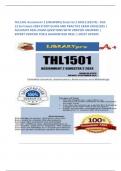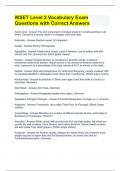THL1501 ASSIGNMENT 2 (ANSWERS) SEMESTER 2 2024 (162579) - DUE
12 SEPTEMBER 2024 STUDY GUIDE AND PRACTICE EXAM 2024/2025 |
ACCURATE REAL EXAM QUESTIONS WITH VERIFIED ANSWERS |
EXPERT VERIFIED FOR A GUARANTEED PASS | LATEST UPDATE
,pdf:
https://mthoyibi.files.wordpress.com/2011/05/a-glossary-of-literary-terms-7th-ed_m-h-
abrams-1999.pdf
https://www.poetryfoundation.org/learn/glossary-terms - ✔✔ANSW✔✔..
potential terms:
verso/recto/colophon
mountweazel
annals
pun/paranomasia
epic theater
book/parchment/vellum/codex/palimpsest/illuminated manuscript/incunabula
climax (rhetoric)
manifesto
new philology
dizain - ✔✔ANSW✔✔..
abecedarian - ✔✔ANSW✔✔..a poetic form guided by alphabetical order; generally,
each line or stanza begins with the first letter of the alphabet and is followed by the
successive letter, until the final letter is reached
most probably the oldest type of acrostic; origins have been linked to either the sacred
nature of letters and the mystical significance of these types of arrangements or its
didactic use as a mnemonic and instructive device for children; this second type, mostly
in the form of rhythmic arrangements or songs, is still popular and widely used tool to
teach children the alphabet or other concepts;
oldest found are of Semitic origin; all of the confirmed acrostics in Hebrew Bible are
alphabetic; occur in all five chapters that make up the Book of Lamentations; acrostics
virtually prove that texts in question were originally composed in writing, rather than
having existed in oral tradition before being put into writing
St. Augustine's well-known example written around 393--psalm against Donatists is
earliest known example of medieval rhythmical verse; important historical sources for
development of orthography; can be proof that some letters were used long ago and
later were totally forgotten; Bishop Constantine of Preslav's from 9th century documents
the early Slavic alphabet; nowadays are written chiefly for children; most famous
example in English literature is Geoffrey Chaucer's ABC
absolute metaphor - ✔✔ANSW✔✔..a metaphor in which there is no discernible point of
resemblance between the idea and the image; has no ground; "we are the eyelids of
defeated caves"; also known as a paralogical metaphor or an antimetaphor
,acatalectic - ✔✔ANSW✔✔..a term describing a line of verse that has a metrically
complete number of syllables in the final foot; almost always the case in English verse,
and so rarely specified; occasionally not the case in trochaic meter
accentual verse - ✔✔ANSW✔✔..verse with a fixed number of stresses per line
regardless of the number of syllables that are present; common in languages that are
stress-timed, such as English, as opposed to syllabic verse which is common in
syllable-timed languages, such as French; particularly common in children's poetry
a traditionally common prosody in Germany, Scandinavia, Iceland and Britain; has been
widespread in English poetry since its earliest recording, with Old English poetry written
in a special form termed alliterative verse, of which Beowulf is a notable example;
Anglo-Saxon poetry generally added two further basic elements to the basic four-beat
pattern: alliteration of three of the four beats, and a medial pause (caesura); Anglo-
Saxon poets made frequent use of epithets to achieve the desired alliteration, and had
various other more complex rules and forms, though these have not been as popular in
later poetry; lost its dominant position in English poetry following the Norman conquest
of England when French forms, with their syllabic emphasis, gained prominence;
continued in common use in all forms of Middle English poetry until the codification of
accentual-syllabic verse in Elizabethan poetry; thereafter it largely vanished from literary
poetry for three hundred years while remaining popular in folk poetry; a notable example
from this period is William Langland's Piers Plowman; a well-known source for such
verse from the post-Elizabethan period is Mother Goose's Melody (1765); experienced a
revival in the 19th century with the development ("discovery") of sprung rhythm by
Gerard Manley Hopkins; though not widely adopted in literary circles, the meter did
catch on, with some poets flirting with the form, and later poets more strictly following it;
a modern codification was given by Robert Bridges in 1921, in his Bridges' Prosody
accentual-syllabic meter - ✔✔ANSW✔✔..an extension of accentual verse which fixes
both the number of stresses and syllables within a line or stanza; highly regular and
therefore easily scannable; usually, either one metrical foot, or a specific pattern of
metrical feet, is used throughout the entire poem, thus we can talk about a poem being
in, for example, iambic pentameter; poets naturally vary the rhythm of their lines, using
devices such as inversion, elision, masculine and feminine endings, the caesura, and
secondary stress
dominated literary poetry in English from Chaucer's day until the 19th century, when the
freer approach to meter championed by poets such as Samuel Taylor Coleridge and
Ralph Waldo Emerson and the radically experimental verse of Gerard Manley Hopkins
and Walt Whitman began to challenge its dominance; in the early 20th century, it was
largely supplanted by free verse through the efforts of Modernists such as Ezra Pound
and Amy Lowell; nonetheless, some poets, such as Robert Frost, W. H. Auden, Keith
Douglas, Robert Lowell, Philip Larkin, Howard Nemerov, James Merrill, Derek Walcott,
Geoffrey Hill, Seamus Heaney and Derek Mahon continued to work (though not
exclusively) in such meters throughout the century; though it has not regained its
, position of dominance within English poetry, it remains viable and popular in the 21st
century, as evidenced by the success of such poets as Richard Wilbur and the various
New Formalists; popular example is She Walks in Beauty
acrostic - ✔✔ANSW✔✔..a poem (or other form of writing) in which the first letter (or
syllable, or word) of each line (or paragraph, or other recurring feature in the text) spells
out a word, message or the alphabet; can be used as a mnemonic device to aid
memory retrieval
relatively simple forms may merely spell out the letters of the alphabet in order--
abecedarius; this form occurs in all the five chapters that make up the Book of
Lamentations and in the Psalms of the Hebrew Bible; prove that the texts in question
were originally composed in writing, rather than having existed in oral tradition before
being put into writing
common in medieval literature, where they usually serve to highlight the name of the
poet or his patron, or to make a prayer to a saint; most frequent in verse works but can
also appear in prose; in chronicles, they are common in German and English but rare in
other languages
often the ease of detectability can depend on the intention of its creator; in some cases
an author may desire an acrostic to have a better chance of being perceived by an
observant reader, such as the acrostic contained in the Hypnerotomachia Poliphili
(where the key capital letters are decorated with ornate embellishments); may also be
used as a form of steganography, where the author seeks to conceal the message
rather than proclaim it; achieved by making the key letters uniform in appearance with
the surrounding text, or by aligning the words in such a way that the relationship
between the key letters is less obvious; referred to as null ciphers in steganography,
using the first letter of each word to form a hidden message in an otherwise innocuous
text; using letters to hide a message, as in such ciphers, was popular during the
Renaissance
act - ✔✔ANSW✔✔..a division or unit of a theatre work, including a play, film, opera, and
musical theatre; can either refer to a conscious division placed within a work by a
playwright or to a unit of analysis for dividing a dramatic work into sequences; defined
by elements such as rising action, climax and resolution; introduced in England by
Elizabethan dramatists, who imitated ancient Roman plays by structuring action into
five; late in nineteenth century number of writers followed example of Chekhov and
Ibsen by constructing plays in four; in present century most common form for
nonmusical dramas has been three
Roman theatre was the first to divide plays into a number of such separated by
intervals; may be further divided into scenes; in classical theater each regrouping
between entrances and exits of actors is a scene, while later use describes a change of
setting; modern plays often have only one level of structure, which can be referred to as
either scenes or such at the whim of the writer; and some writers dispense with firm





